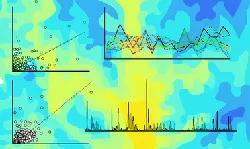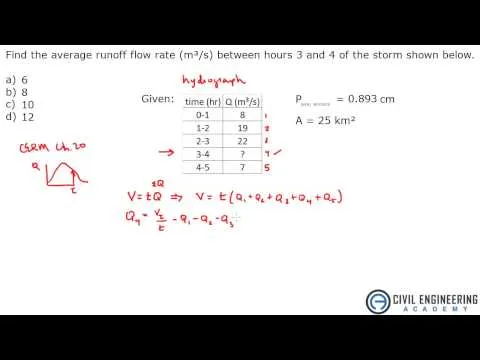
Computational Watershed Hydrology 
Learn how to analyze and model water movement in natural settings with the Computational Watershed Hydrology course. Access and process geospatial and temporal data using GIS, including digital elevation models, land use, soil, streamflow, and precipitation. Develop hydrologic and hydraulic models such as HEC-HMS, HEC-RAS, and SWAT. Interpret model results and effectively communicate the impact of climate and human factors on watershed hydrology. Gain the skills to perform hydrologic and hydraulic analysis in research and professional practice, addressing crucial issues related to water availability and movement. Enroll now to become an expert in computational watershed hydrology. ▼
ADVERTISEMENT
Course Feature
![]() Cost:
Cost:
Free
![]() Provider:
Provider:
Edx
![]() Certificate:
Certificate:
Paid Certification
![]() Language:
Language:
English
![]() Start Date:
Start Date:
Self paced
Course Overview
❗The content presented here is sourced directly from Edx platform. For comprehensive course details, including enrollment information, simply click on the 'Go to class' link on our website.
Updated in [September 26th, 2023]
What does this course tell?
(Please note that the following overview content is from the original platform)
Students in this class will learn how to access and process commonly used geospatial and temporal data such as the digital elevation model (DEM) land use soil streamflow and precipitation using geographic information systems (GIS) After processing students will learn how to use these data to create hydrologic and hydraulic models such as HEC-HMS HEC-RAS and SWAT Students will learn how to interpret model results and present information to convey the role of climate and human factors on watershed hydrology After completing this course students should be able to perform hydrologic and hydraulic analysis or modeling in research and professional practice to address issues related to water movement and availability in natural settings
We considered the value of this course from many aspects, and finally summarized it for you from two aspects: skills and knowledge, and the people who benefit from it:
(Please note that our content is optimized through artificial intelligence tools and carefully reviewed by our editorial staff.)
What skills and knowledge will you acquire during this course?During this course, students will acquire the following skills and knowledge:
1. Accessing and processing geospatial and temporal data: Students will learn how to access and manipulate commonly used data such as digital elevation models (DEM), land use, soil, streamflow, and precipitation using geographic information systems (GIS).
2. Creating hydrologic and hydraulic models: Students will learn how to use the processed data to develop hydrologic and hydraulic models, including HEC-HMS, HEC-RAS, and SWAT. These models are widely used in the field of watershed hydrology.
3. Interpreting model results: Students will gain the ability to interpret the results generated by the hydrologic and hydraulic models. This includes understanding the impact of climate and human factors on watershed hydrology.
4. Presenting information: Students will learn how to effectively present their findings and convey the role of climate and human factors in watershed hydrology. This skill is crucial for communicating research findings and addressing water-related issues in professional practice.
5. Performing hydrologic and hydraulic analysis: By the end of the course, students should be able to independently perform hydrologic and hydraulic analysis or modeling. This will enable them to address real-world issues related to water movement and availability in natural settings.
Who will benefit from this course?
This course on Computational Watershed Hydrology will benefit students and professionals in various fields, including:
1. Environmental Science and Engineering: Students and professionals in this field will gain valuable skills in accessing and processing geospatial and temporal data related to watersheds. They will learn how to create hydrologic and hydraulic models using GIS, which will enable them to analyze and address issues related to water movement and availability in natural settings.
2. Water Resource Management: Professionals working in water resource management will benefit from this course as it will provide them with the necessary tools and techniques to analyze and model watershed hydrology. They will be able to assess the impact of climate and human factors on water availability and make informed decisions regarding water allocation and management.
3. Hydrologists and Hydraulic Engineers: This course will be particularly beneficial for hydrologists and hydraulic engineers who are involved in research and professional practice related to water systems. They will learn how to interpret model results and present information effectively, allowing them to contribute to the understanding of watershed hydrology and develop sustainable water management strategies.
4. GIS Specialists: Individuals with expertise in Geographic Information Systems (GIS) will find this course valuable as it focuses on utilizing GIS for processing and analyzing geospatial data related to watersheds. They will learn how to integrate various datasets and create models that can be used for hydrologic and hydraulic analysis.
Course Provider

Provider Edx's Stats at AZClass
Discussion and Reviews
0.0 (Based on 0 reviews)
Explore Similar Online Courses

Animating in Procreate: Simple Steps to Create Awesome Animations

Beginner Spanish Spanish Level 1 A1 B1

Python for Informatics: Exploring Information

Social Network Analysis

Introduction to Systematic Review and Meta-Analysis

The Analytics Edge

DCO042 - Python For Informatics

Causal Diagrams: Draw Your Assumptions Before Your Conclusions

Whole genome sequencing of bacterial genomes - tools and applications

Water Resources - Hydrograph Flow Rate in Hydrology

Hydrology: TSPSC - CIVIL - AEE Polytechnic Lecturer Important Concepts & Questions ACE Online


Start your review of Computational Watershed Hydrology